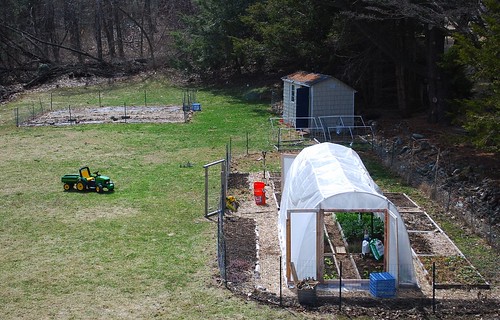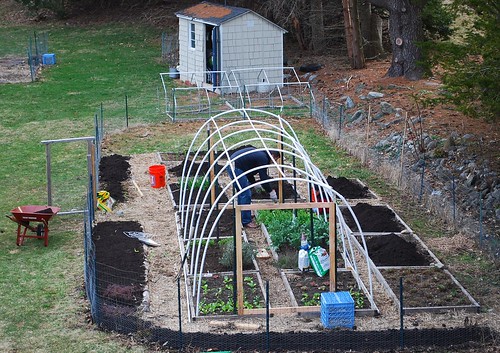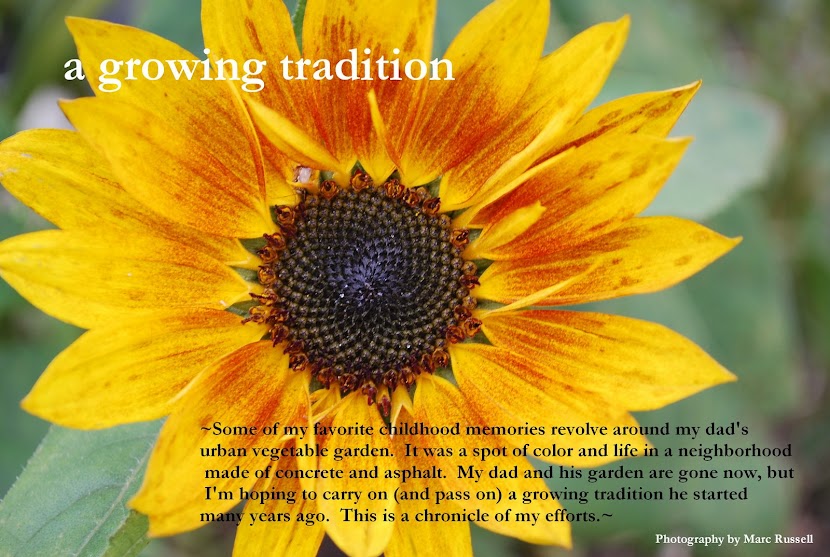
Looking at this picture, you would think it was still mid-March. This spring (at least in my opinion) has been a bit cooler than usual thus far and I think we are at least a couple of weeks behind schedule temperature-wise. However, it seems Mother Nature is now playing catch up as it's expected to get into the 60's during the next six days. (I need to plant peas ASAP!)
Anyway, I thought I'd take a few pictures this weekend to document the progress we're making each day. The ground is still soft but no longer muddy and the beds have dried up quite a bit. We only had a couple hours to work in the garden today but it felt really good to break a sweat under the mid-afternoon sun.

We took the plastic off of the hoop house today mainly because the inside temperature was reaching into the 90 degrees during the day (bad for spinach and Asian greens) and also because I was really sick of looking at it. I would have just taken off the doors but it was casting a shadow as well. The frame will be kept up this summer as I'm thinking of growing pole beans or cucumbers on them. This fall, I'll move the hoop house a row over so that it no longer casts a shadow and install the professional greenhouse plastic.
We also cleaned up most of the beds and started to lay down the compost. Anyway, here is my question to all you out there:
Do you dig your compost into the soil or just let it rest on top? Obviously, digging it into the soil would be the more conventional approach but I've read an article or two that said that leaving the compost on top (or working it lightly into the top two inches of the soil) and allowing the worms to bring it down slowly mimics nature to a greater extent and is therefore more beneficial to your plants. On the other hand I've also read that sunlight can diminish the quality of compost. For heavy feeders such as melons and tomatoes, I can see the benefits of digging a deep hole and filling it with compost, but I wonder if turning the compost into the soil is really necessary most of the time. The lazy garden in me hopes not. Any thoughts on the issue?






Who you calling "masses", Sir? :-)
ReplyDeleteI say let it sit up top, but I would be hard-pressed not to dig, myself.
Dig! Dig!
I don't know.
Yeah. Dig.
Ive done both, digging it in and not... It seemed to me to do better with the digging in... But you have so many beds perhaps you could do an experiment and only dig some?
ReplyDeleteLast year we dug in compost, vermiculite, and peat. This year we added some more and turned the top over to aerate. In our big garden, we dumped the homemade compost and will dig it in only where the plants will go and let the rest sit on top. It sure seems to result in less worms chopped up.
ReplyDeleteI usually work mine into the top few inches, although I used to double dig my beds and place the compost at the bottom of the trench before adding the soil over the top of it.
ReplyDeleteThis year, forming the new beds, I spread compost over the top, turned it under the depth of the shovel, then added another layer of compost to the top of the bed and worked it into the top few inches. Except the onion bed, where I had onion plants before I had compost. I just scattered a layer over the top after the onions had been planted. I don't know it that will be enough for a good crop or not.
haven't a clue but also would love to know for next year
ReplyDeleteI usually just work it into the top few inches a little bit. I do side dress some plants that have been in the ground over the winter and sometimes during the growing season too.
ReplyDeleteI've done both. I tend to the no dig, but sometimes I dig. Whenever my compost is not completely broken down I do no dig as I don't want to mix the partially composted leaves into the soil. But for really good screened compost that isn't an issue.
ReplyDeleteThis year with purchased compost I'm doing my regular lazy way. I put two inches on top of all the beds. Before I plant up I fertilize on top (I ought to have fertilized under, but I'd rather not put on the fertilizer until I'm about to have plants in the bed and I have no where to store that much compost). Then I aerate the beds with a pitchfork. The way I do it, it does bring up some soil from the bottom but not much It also lets the fertilizer sift down a bit as that shouldn't be on top.
This year is weird though. I don't really have soil layers. I have 18" of good soil all the way down. And I have zero worms. I'll be so happy when I see my first one. I'm assuming they will eventually more in. I wish I could import a few to get the process started though. It freaks me out to not see one worm when playing in the soil. My last house you couldn't dig at all without finding an army of them.
If it is an established bed, I just stir it in the top couple of inches. If I am starting a new bed, I double dig and add tons of compost to the top 30cm or so.
ReplyDeleteSo my advice is just stir it in a bit as you plant.
I don't see any disadvantages to digging it in. It does reach the roots more easily and quickly if you dig it in. The only disadvantage to letting it sit on top is that it can dry out. The microorganisms that are active in cured compost need a little moisture to remain alive. If you are simply using compost as a mulch, this does not really matter.
ReplyDeleteI'm a digger.
ReplyDeletePersonally, I would say it depends on your soil texture. If the topsoil is sandy loam, nutrients can be transferred to the roots easily, then no dig. If it is clayey, the soil permeability is low, not too much nutrients can be transferred, so dig.
ReplyDeleteI love reading everyone's opinion on this issue. Thanks everyone!
ReplyDeleteI do both. If there's compost ready when I'm preparing a bed I'll dig some in along with the usual amendments, if there isn't any then I skip the compost. I also like to put a thin mulch of compost around more established plants. I avoid putting a compost mulch around seedlings since my compost is always full of sowbugs which have a bad habit of munching my baby plants.
ReplyDeleteI dig mine in. The reason is because compost left on top will dry out really bad from the sun - causing watering issues..
ReplyDeleteJust dig it in to the top few inches. You want to mix it in with some actual dirt, i.e., rock dust so that it helps make the minerals in the dirt plant-available. But deep digging just destroys the soil structure as well as exposing the beneficial bacteria and mycorrhizae to harmful exposure. If you have any rock dust you should mix it in the compost first. You can go to a local quarry and get a load very inexpensively. You probably know about the Remineralize the Earth organization and nutrient dense farming.
ReplyDeleteI am so pleased you asked this question as the responses were great and I learned a few things. If it's an established bed we just lay ours on top and let the worms do the work, but a new bed, we would work it in. Still, after reading all the comments, think I will go out to the asparagus bed and mix ours in a bit more with the soil. Thanks.
ReplyDeleteI think if your soil is good and not too compacted, and you have been regularly amending it with compost and other nutrients, then you don't have to dig in anything. Just lay them on the top and let nature work the ingredients together.
ReplyDeleteI would be careful when working around asparagus as you need to be very careful not to damage the roots. This could allow fusarium or other problematic diseases to attack your plants. Top dress and allow the nutrients to slowly seep down to the roots.
When I first create a bed, I double dig it and add compost into the bottom of the lower trench as it is being loosened (along with rock minerals) and then add another layer on top and work it into the top few inches. I also dig compost in when planting a new perennial or tree that will be there for a long time. Otherwise, my routine annual bed amending and rejuvenation consists of laying on some compost, using a broad fork to aerate the bed (not turning it over just deep lifting). I then broadcast some all purpose organic fertilizer over the top and dig it and the compost into the top few inches of soil - rake it smooth and I am done.
ReplyDeleteThe last two years I planted a cover crop in the fall and dug it into the soil before the winter freeze, no other digging than that. Spring and summer everything just goes on top, my garden has performed really well the last two years, but then again...maybe it's just a coincidence!
ReplyDeleteWhether to dig or not i don't know.
ReplyDeleteGood post.
Thanks for sharing the post.